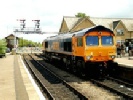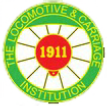Archive Section




© By Peter Lindop
A group of 12 gathered by the North Eastern Railway signal box at York Station on Wednesday 21st April for the first visit of this summer's season. Using taxes, we made the short journey to the Thrall Europa works. Here we met our guide for the visit, Operations Director Bob Brandon.
He started by giving us a short history of the company, followed by a question and answer session. The works is built on part of the site of the carriage works, opened by the N.E.R. in 1884 and closed by ABB in December 1995. On a tight time scale, contracts for Thrall wore exchanged in June 1997, the site opened on 9th February and the first wagon finished in June 1998 (although officially rolled out on 27th July 1998). York in the first works in Europe for Thrall (another is being set up), which has four main plants in America -
York has around 200 staff, about 30% being ex-
We then went on our tour of the site. It has 12 roads/bays areas along the length of the building. The first three where the raw material is cut, formed and fabricated. Next is the welding school, staff being trained to a high standard and tested every six months. Surplus machinery following the set-
Six road is where the American swing-
A traverser (to save space) runs along the west side of the building to connect all the roads with storage siding and the main line connection to the north of the site. Another connects some roads on the other side of the building.
The initial order for 2,500 wagons until 2003 allows a good start for the works. Three types of bogie wagons are currently being built, production is around 15 per week, although this can be increased.
300 MBA monster box wagons, nicknamed Gondola, of which 30 were ready. 100 FAA low platform wagons, for 1 x 40' or 2 x 20’, 9’6” high containers. Several were seen completed and stacked around the building, waiting for bogies. There were also 50 BRA covered coil carriers.
An order for 260 BYA covered colt steel wagons has already been completed. These are built using British Steel, bought and operated by EWS, who then use them to move British Steel products -
A group photo was taken with a background of three wagon types and the four-
A good day was had by all.